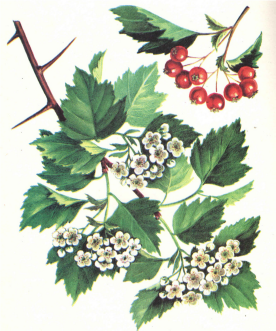Hawthorn — Crataegus
Tall shrubs or small trees. Some branches of certain species have straight axillary thorns. Leaves are alternate, with stipules, short-petiolate, simple, more or less deeply lobed, with a large, toothed edge. Flowers are small, white, arranged in corymbs. Each flower consists of a green, externally pubescent, cup-shaped receptacle, bearing a five-lobed calyx, five free white petals, and numerous stamens with purple anthers. The ovary is inferior. The fruit is a false, apple-like drupe, fleshy, nearly spherical, with an annular border and five calyx teeth at the top; inside, seeds have an angular, light-yellow woody shell. Crataegus usually blooms in May–June and bears fruit in August. Species are mainly differentiated by leaf shape, pubescence, fruit size and color, number of stones, presence of thorns, and, to some extent, by branch color.
Crataegus oxyacantha L., also known as common hawthorn, is well studied and collected. It is not found in the wild but is cultivated in gardens and parks in central Europe, Ukraine, and the Baltic states. Its origin is Western Europe.
Among wild species, Crataegus sanguinea Pall., or blood-red hawthorn, is widely collected. It is distinguished by thin, purplish-brown, glossy branches; short-hairy leaves on both sides; and fruits with 3–4 stones.

Crataegus sanguinea grows in forest-steppe zones and southern forest regions. It is most common in Western Siberia and extends to eastern European regions. In Eastern Siberia, it is gradually replaced by the closely related Crataegus dahurica Koehne, which has orange-red fruits.
In Ukraine, Crataegus kyrtostyla Eingern., Crataegus pentagyna W. et K., and Crataegus curvisepala are found.
Two types of raw materials are collected: Flores Crataegi and Fructus Crataegi. Flowers are collected at the beginning of flowering, including some buds, separated into parts, and dried in the shade. Ripe fruits are harvested by removing entire corymbs, then removing peduncles, unripe, or spoiled fruits, and drying them in the sun or in moderately heated ovens.
The flowers, fruits, and leaves of Crataegus oxyacantha contain complex active compounds: several flavonoids, triterpene saponins, sapogenins, ursolic and oleanolic acids, choline, acetylcholine, and derivatives. Flavonoids include hyperoside, quercetin, vitexin, chlorogenic acid, and caffeic acid. Seeds contain amygdalin, and the fruit pulp contains tartaric and citric acids and sugars; the fruits have up to 200 mg of vitamin C and carotene.
In medicine, liquid extracts from fruits or tinctures from flowers are used for cardiovascular diseases as heart muscle tonics, sedatives, and hypotensive agents. They are prescribed in doses of 20–30 drops, 3–4 times a day. The complex preparation «Cardiovalen» contains Crataegus extract.
